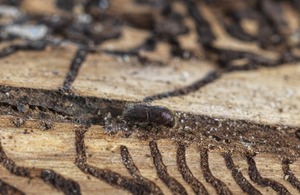New warning as Ips typographus tree pest found on new species
Eight-toothed spruce bark beetle found on Sitka spruce trees in the UK for the first time

Woodland managers, landowners and the forestry industry are encouraged to remain vigilant as the Forestry Commission today (Thursday 25 July) announces a number of new Ips typographus findings in the South East of England.
Also known as the eight-toothed spruce bark beetle, Ips typographus is a serious pest of spruce trees in Europe which was first identified in the UK in 2018. It prefers stressed or dying trees but under the right conditions it can attack healthy trees and has the potential to cause significant damage to Great Britain’s forestry and timber industries.
Following extensive surveillance, further outbreaks have now been found in the Demarcated Area in Kent and West Sussex, adding to the number of outbreak sites detected this year. The Forestry Commission continues to take swift and robust action including rapid eradication measures in response to the findings.
The finding of Ips typographus on a small number of cut and fallen Sitka spruce trees in close proximity to infested Norway spruce trees on a site in West Sussex marks the first time the beetle has been discovered on this species. There is no evidence of spread within the UK and the recent outbreaks are most likely due to natural dispersal of the pest from mainland Europe.
Defra Chief Plant Health Officer Professor Nicola Spence said:
“We can confirm that new findings of Ips typographus in the South East of England have been reported by the Forestry Commission on a small number of cut and fallen Sitka spruce trees in West Sussex.
“All landowners and land managers should remain vigilant for Ips typographus as temperatures rise, continuing to check the health of spruce trees on their land. Landowners, agents and timber processors should note ongoing restrictions for movement of spruce material and methods of forest operations in the Demarcated Area.”
Forestry Commission Director of Forest Services Dr Anna Brown said:
“Rapid eradication measures are being taken, alongside wider surveillance to determine the scale of the outbreak, and identify further management steps required.”
The Forestry Commission is urging landowners to be vigilant and report any sightings of this beetle anywhere in Great Britain using the TreeAlert form in order to help reduce risk.
Landowners are encouraged to proactively remove spruce from the South East of England and replant with other non-susceptible species. They may also be eligible for funding if their land is in the ’Proactive Spruce Removal area’. Landowners and managers served with a Statutory Plant Health Notice due to an outbreak on their site may be eligible for grants to support felling and restocking activity through the Tree Health Pilot.
This announcement follows the introduction of new measures outlined on 5 June to protect against the impact of Ips typographus through the extension of the Demarcated Area. A Demarcated Area is in place in the South East of England and East Anglia to prevent potential spread of the pest, in line with the eradication action taken by the Forestry Commission to manage outbreaks. Within the Demarcated Area, the felling and movement of all spruce material, including trees and wood with bark, isolated bark, and wood chip with bark, is prohibited unless authorised by the Forestry Commission. Click here for full guidance of the requirements.